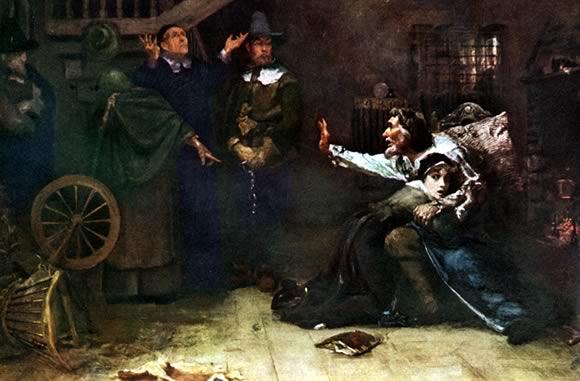Irish Legal Heritage: The Witch of Youghal

Accused of Witchcraft (1884) by Douglas Volk
On 24 March 1661, Florence Newton was committed to prison in Youghal, Co Cork, having been accused of bewitching a young servant girl named Mary Langdon.
At Florence’s trial on 11 September 1661, Mary gave evidence that the previous Christmas, Florence had gone to the house of John Pyne, where Mary worked, and asked for “a piece of beef out of the powdering tub”. Mary’s refusal to give away her master’s beef angered Florence, who said “thou had’st as good give it to me” and mumbled threats under her breath as she left. The following week, Mary claimed that she met Florence again, who violently kissed her and said, “I pray thee let thee and I be friends, for I bear thee no ill will and I pray thee do thou bear me none” (St. John D. Seymour, Irish Witchcraft and Demonology (1913))
Mary said that within a few days of this encounter, she saw Florence and the Devil standing by her bedside, tempting her to become a witch (Andrew Sneddon, Witchcraft and Magic in Ireland (Palgrave 2015), 79). Rejecting the offer, Mary told the Devil that she had “nothing to say to him, for her trust was in the Lord”. Over the next month, Mary was possessed with fits so violent that “three or four men could not hold her”, and that she would “vomit up needles, pins, horsenails, stubbs, wool, and straw”. John Pyne also gave evidence at the trial, stating that he saw Mary’s fits himself – in one, he said, she was reading the Bible, and all of a sudden it was “struck out of her hand into the middle of the room, and she immediately cast into a violent fit” (St. John D. Seymour, Irish Witchcraft and Demonology (1913)).
Florence was also accused of bewitching to death a prison guard called David Jones. David’s widow, Elenor Jones, gave evidence that in April 1661, David had come home from “standing sentinel over the witch all night”, and told her that Florence had kissed his hand; bewitching him and causing him great pain in his arm. Elenor’s evidence was that David never recovered from the pain which then spread to his heart, and that he cried out against Florence Newton from his death bed (St. John D. Seymour, Irish Witchcraft and Demonology (1913)).
With no record of the verdict, it has long been assumed that Florence was found guilty and executed under an Elizabethan Statute known as the 1586 Irish Witchcraft Act; however, in a forthcoming article in Irish Historical Studies, ‘Florence Newton’s trial for witchcraft, Cork, 1661: Sir William Aston’s transcript’, Andrew Sneddon examines the full transcripts of the trial, which suggest that Florence died before she could be executed.










